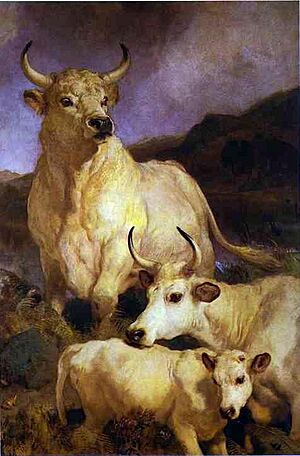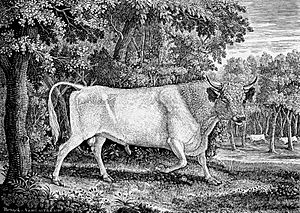Chillingham cattle facts for kids
Quick facts for kids Chillingham cattle |
|
|---|---|

A portion of the Chillingham cattle herd grazing
|
|
| Lua error in Module:Location_map at line 420: attempt to index field 'wikibase' (a nil value). | |
| Location | Northumberland, England, UK |
| OS grid | NU074256 |
Chillingham cattle, also known as Chillingham wild cattle, are a special type of cattle. They live in a big park at Chillingham Castle in Northumberland, England. This herd is quite unique because it has lived in the same park for hundreds of years.
Even though they are cattle, they act like wild animals. They have stayed separate from other cattle breeds for a very long time. In 2009, there were about 90 of these animals in the park. There is also a smaller group of about 20 Chillingham cattle in North East Scotland.
Contents
Meet the Chillingham Cattle
Chillingham cattle are related to White Park cattle. However, the Chillingham herd has kept its unique features. These cattle are quite small. Both males (bulls) and females (cows) have horns that point upwards.
A bull usually weighs around 300 kg (660 lb). A cow weighs about 280 kg (620 lb). They are mostly white. But they have colored ears, and sometimes color on their feet, nose, and around their eyes. Chillingham cattle have red ears. Most White Park cattle have black ears.
Explore Their Northumberland Home
The park where the Chillingham cattle live is very old. It has large oak trees scattered among grasslands. This makes it look like Britain might have looked in medieval times. Many of these oak trees were planted in the late 1700s.
The oldest trees in the park are alder trees found near streams. These trees are very ancient, possibly hundreds of years old. The park is home to many different plants and animals. This is because it is not used for intensive farming like most other places in Britain.
The park is also home to other animals. You might see red squirrels, foxes, and badgers. There are also roe deer and fallow deer. About 55 types of birds live here too. These include common buzzards, European green woodpeckers, and the Eurasian nuthatch.
A park warden can guide visitors to find the cattle. Sometimes they are easy to spot in the meadows. Other times, you might need to walk a bit to find them. This is because they have a lot of space to roam.
Chillingham Cattle: A Look at Their Past

Some people used to think Chillingham cattle were direct descendants of the ancient aurochs. Aurochs were wild oxen that lived in these lands long ago. They believed these cattle had never been tamed. However, it is now thought that they likely came from farm cattle that were enclosed in the park during medieval times.
The first written record of the herd is from 1645. But some believe the herd has been at this site for at least 700 years. In the 13th century, Chillingham Castle was made stronger. A drystone wall might have been built then to keep the herd inside. This was partly to protect against Scottish attackers.
The wall you see today at Chillingham was built in the early 1800s. It enclosed about 1,500 acres (610 ha) of Chillingham Park. As of 2009, the cattle have 330 acres (130 ha) to roam. The rest of the land is woodland or farmland.
Their Unique Genetics
Chillingham cattle are known for being very pure. This means their genes have not mixed with other cattle breeds for a long time. Early studies in the 1960s looked at their blood groups. They found the herd was very similar genetically. This is expected from a group that has been isolated for so long.
Later DNA studies confirmed these findings. This genetic purity is very rare. It helps scientists understand how animals can survive with limited genetic variation.
How Chillingham Cattle Behave
The Chillingham cattle are not tame. They act like truly wild animals. This means studying them can give us clues about how ancient wild cattle might have behaved. Even though they are descendants of domesticated animals, no one handles or tames them.
They breed all year round. Bulls share "home territories" with other bulls and cows in the herd. They might have sparring matches with other bulls in their area. In the past, studies showed that cows had a complex social structure. Bulls had a clear "peck order" or hierarchy.
The cattle are very noisy. They make special calls that echo around the park. This is especially true when bulls get excited if a cow is ready to breed. Traditionally, it was thought that one "king bull" would father all the calves for a few years. But this might not happen when the herd is very large.
Recent History and Protection
In 1939, the Chillingham Wild Cattle Association Limited was formed. Its goal was to study and protect these special animals. In 1963, it became a charity. The herd's population dropped very low in the harsh winter of 1946-1947. Only 13 animals survived.
In 1971, the herd was given to the Association. In 1980, the park was bought by the Sir James Knott Trust. This trust helps protect Northumberland. The Association later bought the park and surrounding woodlands in 2005. This brought the herd and its home under the same ownership.
These cattle have a unique status. They are a type of farm animal, but they live wild. Because they are cattle, they would be affected by diseases like foot-and-mouth disease. So, keeping them healthy and safe from diseases is very important.
In March 2015, the herd had about 100 animals. There were roughly equal numbers of males and females. Since 2005, sheep have been removed from the park. This means there is more grass for the cattle. Their health and breeding rates are improving. There is also a small group of about 20 cattle in Scotland.
Other Herds of White Cattle

The first list of park cattle herds was made by Thomas Bewick in 1790. It included herds like Chartley, Chillingham, and Lyme Park. The history of many of these white park cattle herds is not always clear. A key book on the topic is Whitehead's The Ancient White Cattle of Britain and their Descendants.
In 1759, the Earl of Eglinton started a herd of ancient white cattle in Scotland. He probably used cattle from the Cadzow Castle herd. But these animals were hornless, and their numbers later dropped.
Images for kids











